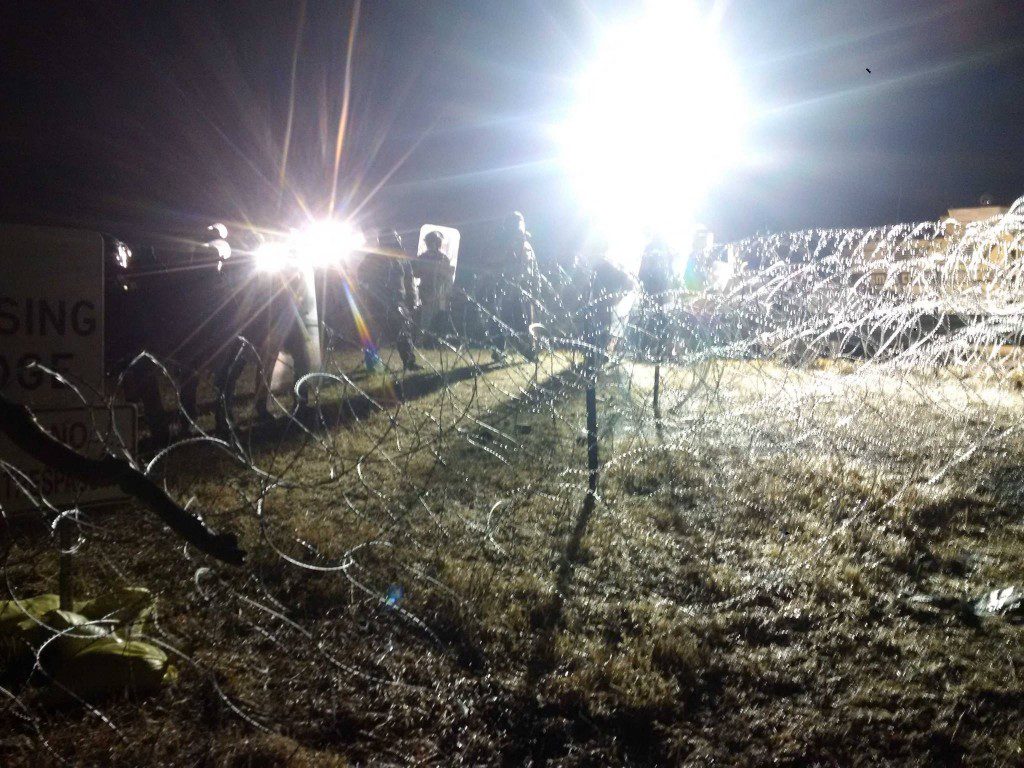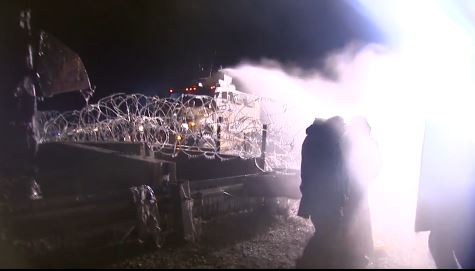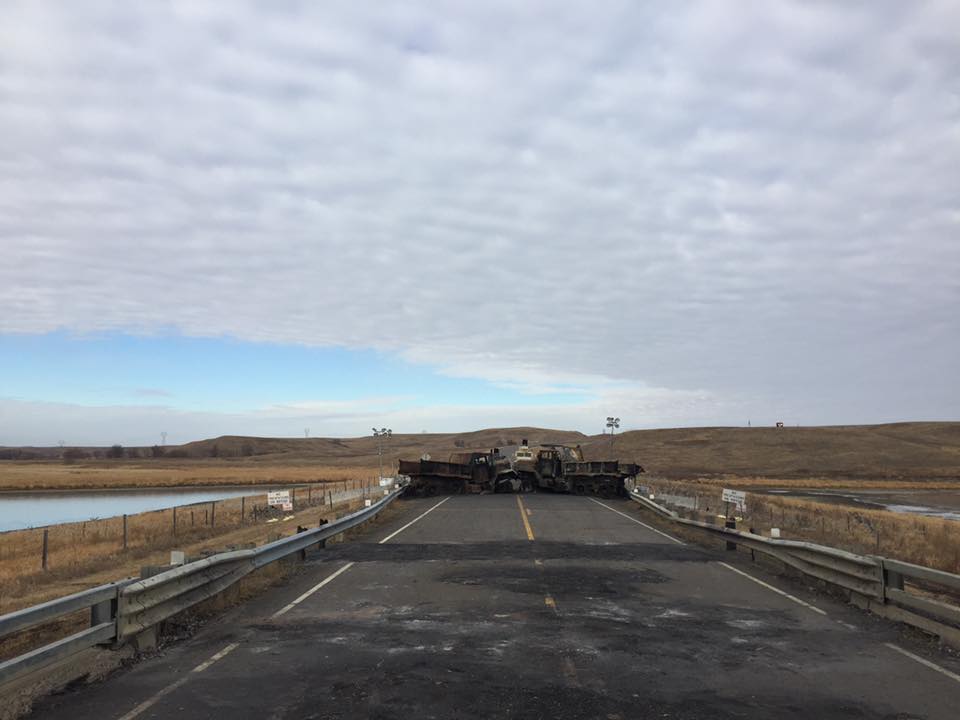Jorge Barrera, Damian Joseph and Tom Fennario
APTN National News
BACKWATER BRIDGE, ND—State and county authorities in North Dakota pummeled hundreds of people with tear gas, rubber bullets and water cannons in sub-zero temperatures Sunday evening a few hundred meters from the Oceti Sakowin Camp, the heart-beat of a Native American-led movement against a four-state, $3.78 billion oil pipeline project known as Dakota Access (DAPL).
The hours-long battle saw police repeatedly use water cannons and tear gas, along with targeted pot shots with rubber bullets, against the demonstrators known as water protectors, who defended themselves with makeshift shields and tarps. Police also reportedly used flash grenades and pepper spray.
With temperatures hovering at about -3C, the water fired by police quickly froze, caking clothing and blankets worn by the demonstrators with ice. Icicles clinging to the edges of the razor blades on the concertina wire gleamed in the flood lights set up by authorities along a barricaded frontline established just over the Backwater Bridge on Hwy 1806 following intense clashes the month before.
“It’s getting pretty wild down there, (police) shooting things, doing the tear gas thing,” said a masked water protector during the height of the struggle. “See all the people coming back, they are being shot with rubber bullets….They are being hit in the head, it’s getting ugly over there.”

The water protectors continually rushed the injured from the front lines into the backs of waiting pick-up trucks which would then transport them to the medical station in the Oceti Sakowin Camp, which sits by the Standing Rock Sioux Tribe reservation. Serious injury cases were put into ambulances operated by the Bureau of Indian Affairs, said frontline volunteer medic Melanie Stoneman.
“We have more women injured, our women are getting shot directly in the head (by rubber bullets),” said Stoneman.
Stoneman said she saw injuries ranging from a broken arm, bleeding caused by rubber bullets to burning eyes and shortened breath caused by the tear gas.
The Standing Rock Medic and Healer Council issued a statement late Sunday evening calling on the Morton County Sheriff’s Department, which is the lead law enforcement agency on the ground, to cease using water cannons.
“As medical professionals, we are concerned for the real risk of loss of life due to severe hypothermia under these conditions,” said the statement.
Whether by intention or happenstance, authorities repeatedly trapped the water protectors on the narrow, two-lane bridge by firing from water cannons to push them back away from the barricade while tear gas canisters arced overhead landing amid and behind the frontline knot of people.
“They are using water guns, really powerful water hoses on these peaceful demonstrators where the temperature here is really cold,” said Graeme Cabrera, from Long Beach, Calif., who was drenched with water at the frontline. “The officers know, at least the ones firing the water, they are intentionally causing hypothermia to the ones they are blasting.”

Sandy Ostrem, from Minneapolis, said it was necessary for the water protectors to face the fury of the water cannons and tear gas.
“If we walk away and we are silent, what is going to happen? And at some point we’ll say, ‘Oh geez, I guess we’ll have to drink oil or eat money,” said Ostrem. “This is a time we have to stand, even if it seems senseless.”
The Morton County Sheriff’s Department issued a statement on its Facebook page claiming the water protectors had “started a dozen fires near the bridge.” The statement said there were about 400 people at the site “attempting to breach the bridge to go north on Hwy 1806.”
The only fire on the bridge noticed by APTN at the scene was a small bonfire used by people to stay warm. People gathered around a larger bonfire which was lit on the north bank of the Cantapeta Creek to the right of the Backwater Bridge facing the barricades. Authorities aimed a water cannon at that bonfire but it was not powerful enough to reach it.
Water protectors described a different scenario than the one issued by the Morton County Sheriff’s Department on what began Sunday’s events.
Police unleashed the water cannons after a group of about half a dozen men earlier in the evening managed to tow away the charred remains of one of two military cargo trucks left alongside the barricade erected on Oct. 27. That barricade was erected after police and troopers from several states and counties pushed the water protectors out from a camp set up north of the Oceti Sakowin Camp.
Greg Urquhart, a U.S. veteran of the Iraq war, said he helped the group fasten chains onto the charred truck.
“A semi-truck came reversing at full speed back down to the checkpoint up here. Six or seven guys jumped out and some others joined them and with chains tied it around the deuce-and-a-half (the name of the military cargo truck) to drag it out,” said Urquhart, who is of Cherokee ancestry. “Finally we got enough leverage round to get it going.”
Urquhart said authorities began warning the group as more people from the camp began to appear.
“They warned us they would open fire on us. We didn’t listen, we were going to do what we were going to do,” he said. “More people joined in after they started doing that.”
The group tried but couldn’t get the second charred truck out.
“And more people came from the camp and that’s when they opened up,” said Urquhart.
A small crowd remained by the bridge into the early morning hours Monday.

The latest round of clashes between water protectors and authorities comes as all sides await a decision from the U.S. Army Corp of Engineers on whether to grant Houston-based Energy Transfer Partners, the parent company of Dakota Access LLC, an easement to run the pipeline under Lake Oahe, a reservoir on the Missouri River.
The Dakota Access pipeline has been built to the edge of the lake and the construction site is protected by recently erected walls. The company is allowed to drill about 60 metres down into the ground by the water, but can’t drill horizontally until the Army Corp grants the easement.
The Standing Rock Sioux Tribe and the Cheyenne River Sioux Tribe are currently awaiting word from the Army Corps of Engineers to begin meetings to discuss why the easement shouldn’t be granted and, if granted, what conditions should be attached.
This is the believed to be the last step of a review of the project which was announced in September by the administration of U.S. President Barack Obama after Standing Rock failed to obtain an injunction against pipeline construction with the U.S. Federal Court.
The Army Corps of Engineers only has jurisdiction over the pipeline’s path directly adjacent to and under Lake Oahe.
Standing Rock and Cheyenne River say the oil pipeline threatens the area’s water supply.
The proposed 1,886 kilometre pipeline is slated to pump about 500,000 barrels of oil per day from the Bakken shale fields in North Dakota, through South Dakota and Iowa to Illinois.
The pipeline traverses Standing Rock’s treaty territory established in the 1869 Treaty of Fort Laramie.
Last week, Energy Transfer Partners and Sunoco Logistics Partners filed court action with the U.S. Federal Court in Washington D.C. against the Army Corps of Engineers claiming the energy firms already have all the permits needed to drill under the lake.
The Corps replied in a filing Friday saying Energy Transfer and Sunoco both know the easement has not been granted.
The Corps said in its filing it has not yet decided whether to grant the easement.
@damianjay21









